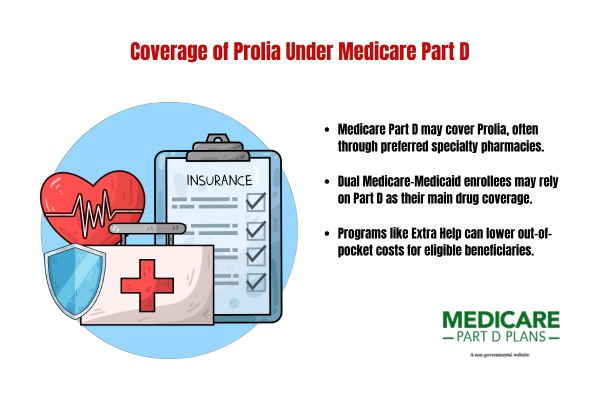Find a Medicare Part D prescription drug plan

Medicare Part D
Prescription Drug Coverage 2026
Is Prolia Covered Under Medicare Part B or D?
If you’re receiving Prolia injections for osteoporosis, you might wonder if Prolia is covered under Medicare Part B or D. Medicare coverage for Prolia may depend on how and where you receive the treatment.
Read on to find out whether Medicare Part B or Medicare Part D will cover your Prolia injections and what you need to know to maximize your benefits.
Key Takeaways
- Prolia will likely be covered under Medicare Part B as it is administered via injection, specifically for certain high-risk patients.
- Medicare Part D may provide coverage for Prolia as a prescription drug but might involve using a preferred specialty pharmacy.
- Patients should confirm Prolia coverage with their Medicare plan to avoid unexpected expenses and discuss potential out-of-pocket costs with healthcare providers.
Understanding Prolia: A Brief Overview
Prolia is a monoclonal antibody designed to combat osteoporosis by targeting and blocking the RANKL protein, which is involved in bone resorption.
Key points about Prolia might include:
- It increases bone density and reduces fracture risk.
- It is particularly beneficial for postmenopausal women and men at high risk.
- It is administered as an injection every six months.
- It provides a convenient option for managing osteoporosis long-term.
Prolia will likely play a key role in osteoporosis therapy by bolstering bone density and reducing fracture risk, likely improving the quality of life for those with this debilitating condition.
Medicare Part B vs. Part D: Key Differences
For Medicare patients, knowing the differences between Part B and Part D may be important. Medicare Part B will likely cover:
- Medical services and some medications administered in healthcare settings
- Doctor visits
- Outpatient care
- Preventive services
- Specific drugs given by healthcare professionals, known as Part B drugs.
Medicare Part D, however, may only cover prescription drugs that will likely be self-administered. This part of Medicare may cover the costs of medications picked up from a pharmacy, likely making it suitable for regular and short-term use.
These differences could significantly affect how osteoporosis therapies like Prolia may be covered. Part B might be more restrictive, while part D plans could offer broader coverage restrictions. Understanding these nuances may help maximize your Medicare benefits and ensure optimal care.
Coverage of Prolia Under Medicare Part B
Prolia (denosumab) is a cornerstone in osteoporosis treatment. If it is administration by injection, it will likely be placed under Medicare Part B coverage.
Medicare Part B may cover Prolia for patients with nonmetastatic prostate cancer or breast cancer, and for men at high risk for fractures on corticosteroids for at least six months. This likely ensures that the most vulnerable may receive the necessary support for bone health.
Medicare Part B may cover up to 80% of the costs for Prolia injections if administered in a healthcare setting and the patient has met their deductible. This could potentially reduce out-of-pocket expenses, possibly making the treatment more accessible.
Consult with your doctor about service frequency and necessity, as Medicare coverage may vary.
Coverage of Prolia Under Medicare Part D
Medicare Part D will likely cover prescription drugs, including Prolia. Some plans may require using a preferred specialty pharmacy for Prolia prescriptions to ensure proper dispensing and management, an important factor when choosing a Medicare plan.
For dual Medicare and Medicaid recipients, Medicare Part D may be the primary source of drug coverage, possibly providing a strong safety net for Prolia users. The Extra Help program may also aid Medicare beneficiaries with limited income, possibly reducing out-of-pocket medication costs.
Grasping the details of Medicare Part D and its coverage for Prolia will likely help navigate drug coverage complexities, possibly ensuring necessary treatment without undue financial burden.
Potential Costs Related to Prolia Injections
The cost of Prolia injections will likely be crucial for many patients. With an average list price of approximately $1,875.43 every six months, understanding the Medicare coverage and out-of-pocket expenses could be vital.
Out-of-pocket costs for Prolia may vary widely based on your Medicare plan and additional insurance. Patients with supplemental insurance like Medigap may not need to pay the remaining 20% of Prolia’s co pay costs.
For low-income individuals, programs like Extra Help under Medicare Part D could significantly assist in covering medication costs, possibly providing a medical benefit. Discussing expenses with your healthcare provider may offer further clarity and could aid in planning treatment costs.
How to Confirm Prolia Coverage
To avoid unexpected expenses, members should confirm Prolia coverage with their Medicare plan provider to understand specific benefits and coverage details.
Resources like the Plan Finder Tool on this website can offer comprehensive information about coverage options and plan specifics. These steps will likely help ensure you understand your coverage and make informed decisions about your osteoporosis treatment.
See plans in your area instantly!
Advertisement
Additional Considerations for Medicare Patients
Medicare patients taking Prolia should consider several factors. Common adverse reactions might include back pain, high cholesterol, and skin reactions, which may need close monitoring.
Patients continuing systemic glucocorticoids might require a careful evaluation before starting a Prolia injection due to potential interactions. In-home health services, with a home health nurse administering injections and ensuring compliance, could be invaluable in preventing glucocorticoid induced osteoporosis and delayed healing.
Discussing these risk factors with your healthcare provider may ensures you have complete information to manage your treatment effectively, likely minimizing risks and maximizing Prolia’s benefits.
Other Available Osteoporosis Therapies
While Prolia may be a popular medication, other osteoporosis therapies may be available. Selective Estrogen Receptor Modulators (SERMs) like raloxifene could increase bone density and may be recommended for postmenopausal women at risk for vertebral fractures.
Zoledronic acid, an intravenous bisphosphonate, might help to reduce fracture risk by slowing bone loss and will likely be suitable for both men and women. Teriparatide, an anabolic therapy, stimulates new bone formation and may be recommended for those at high risk for bone fractures.
Calcitonin, though not a first-line therapy, could be another option for women who are more than five years postmenopausal osteoporosis when other treatments are unsuitable. Knowing these alternatives could help you explore options and find the most suitable other available osteoporosis therapy.
Find a Plan and Enroll Online Yourself!
Advertisement
Summary
Navigating the complexities of Medicare coverage for Prolia might be challenging, but understanding the various distinctions between Medicare Parts B and D is crucial. Whether covered under Part B for specific medical conditions or Part D for broader drug coverage, Prolia remains a vital option for osteoporosis treatment.
By considering the potential costs, confirming coverage, and exploring alternative therapies, you can make informed decisions to manage your bone health effectively. Stay proactive in discussing your options with healthcare providers and leverage available resources to ensure you receive the best possible care.
Frequently Asked Questions
Is Prolia covered under Medicare Part B or Part D?
Prolia may be covered by Medicare Part B if administered in a clinical setting, while it might be covered under Part D when obtained through an outpatient pharmacy. It’s essential to verify your specific coverage details with your provider.
What are the potential costs associated with Prolia injections under Medicare?
Prolia injections will likely have an average list price of about $1,875.43, with Medicare Part B covering about 80% of this cost. Additional assistance may be available through supplemental insurance or the Extra Help program for those eligible under Part D.
How might I confirm if my Medicare plan covers Prolia?
To confirm if your Medicare plan covers Prolia, use this website or call one of our licensed agents at 1-866-930-4039 (TTY 711) Mon-Fri: 8am-8pm EST.
Are there any additional considerations for Medicare patients taking Prolia?
Medicare patients taking Prolia should be mindful of potential adverse reactions and may benefit from home health services for safe administration and monitoring of their injections.
What other osteoporosis therapies might be available besides Prolia?
Aside from Prolia, effective osteoporosis treatments may include Selective Estrogen Receptor Modulators (SERMs), Zoledronic Acid, Teriparatide, and Calcitonin, each offering unique benefits. It’s important to discuss these options with your healthcare provider to determine the best fit for your needs.
Begin Choosing your plan
Advertisement
ZRN Health & Financial Services, LLC, a Texas limited liability company.


